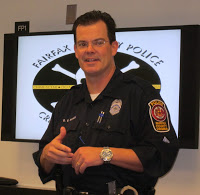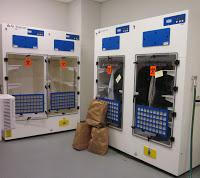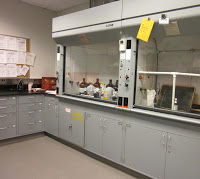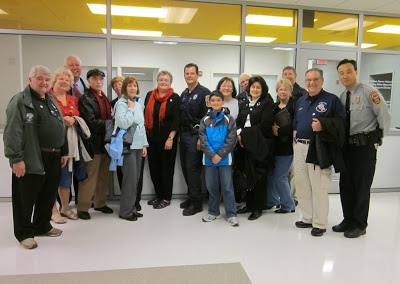CSI: Fairfax
 |
| The Fairfax County communications center where 911 calls are answered |
 |
| Hardy |
“No matter how hard you try to clean up a crime scene, we’ll find evidence,” says Fairfax County Det. Derek Hardy.
Hardy explained how crime scene investigators use state-of-the-art gear to analyze evidence and reconstruct crime scenes to members of the Mason District Police Citizens Advisory Committee during a tour of the county’s forensics lab at the McConnell Public Safety and Transportation Operations Center in Fairfax last week.
Forensics lab personnel respond to 500 crime scenes, process more than 5,000 pieces of evidence, and develop 24,000 photographic images a year, says Hardy, a 19-year veteran of the Fairfax County police force.
About 80 percent of Hardy’s work involves death investigations. There are two types of deaths: attended, where the victim is under the care of a physician, and unattended. The medical examiner takes on cases of unattended deaths if the death appears suspicious and determines if it is a natural death, suicide, or homicide. “We treat every death as a homicide until we can provide it isn’t,” Hardy says.
 |
| Bloody clothing is dried in these chambers |
The county forensics lab handles all investigations other than DNA and firearms, which are carried out by the state’s regional forensics lab in Manassas. DNA results could take as long as six to 18 months.
 |
| Evidence lockers |
Even though DNA analysis has revolutionized detective work in recent years, Hardy says fingerprints are still considered better evidence than DNA. Identical twins have the same DNA but after “hundreds of years of empirical data, no one has been found to have the same fingerprints,” he says. There are even differences among identical twins at birth because they’ve had different experiences in the womb that affect the ridges on their fingertips.
Usable fingerprints are found at crime scenes less than 20 percent of the time, he says. The lab has a new $50,000 coherent laser that should vastly improve the lab’s ability to get results.
Diagramming a crime scene is important to recreate the scene for a jury, Hardy says. For example, a diagram could show where a gun was found, where money was found, and where and when shots were fired.
 |
| Powerful chemicals are stored here |
According to Hardy, if a suspect says he only hit a victim once, a blood stain analysis can show that the victim was struck many times. Ballistics experts use wooden dowels in a car to recreate the flight paths and angles of bullets to help juries understand the order and pattern of gunshots and to prove that a shooting was intentional rather than accidental.
Footprints are often the key evidence in solving a crime, Hardy noted. After bank robberies, detectives use fingerprint powder to capture shoe impressions on the floor. That’s why most banks don’t have carpeting, he says.
Two people wearing the exact same shoes of the same size will leave different foot impressions, because a person’s body build and walking pattern will create a subtle variation. And even if a criminal wears rubber gloves, analysts can find usable fingerprints inside a glove if it is found.
 |
| Police officers sign a fake skull when they leave the department |
Items from crimes are stored in lockers in the “evidence hole,” and only 11 people have access to them. Evidence from homicides is kept forever; there are even items from the 1940s at the lab. Evidence from sex crimes and robberies is retained for 30 years, and items from other crimes are kept for a year.
There are special chambers used for generating super glue fumes which are used to detect fingerprints on guns, plastic, metal, or other nonporous items. A chemical called ninhydrin is used to find fingerprints on porous items like paper.
In Fairfax County, the police department investigates police-involved shootings, rather than the FBI, Hardy says, because Commonwealth’s Attorney Raymond Morrogh “trusts this police department to police ourselves and do it without bias.” There have been a growing number of these incidents, he says, because there are more guns, more gangs, and more drugs, and because “society is becoming more violent toward authority figures.”
 |
| Members of the Mason Police Citizen Advisory Committee and guests |

